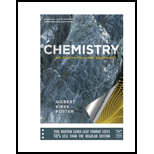
To find: a)How specific heat and molar heat capacity data for the metals support the law of Dulong and Petit.
b) Use these data to predict the specific heat values of nickel and platinum.
Answer to Problem 9.120QA
Solution:a)The product of the
b)
Explanation of Solution
Explanation: 1) Concept:
Law of Dulong and Petit states that “the product of the atomic mass of a metal times its specific heat is approximately constant”.
Specific heat capacity is given by using formula,
2) Given:
| Metal in solid phase | ||
| Aluminum | ||
| Carbon (graphite) | ||
| Carbon(diamond) | ||
| Chromium | ||
| Copper | ||
| Gold | ||
| Iron | ||
| Lead | ||
| Silicon | ||
| silver | ||
| Tin | ||
| Titanium | ||
| zinc |
3) Calculation:
a)To calculate molar heat capacity of the metals, we use the specific heat of metal and atomic mass
For Aluminium:
For Chromium:
For Copper:
For gold:
For Iron:
For lead:
For Silicon:
For Silver:
For Tin:
For Titanium:
For Zinc:
The values of product of atomic mass of a metal and its specific heat are equal to its molar heat capacity. Molar heat capacity value for a metal is constant. Therefore, the Dulong and Petit law is true.
b) Take the average of all the above product values
From the above law, we can write that,
Therefore,
Therefore,
Conclusion:The product of the atomic mass of a metal times its specific heat is constant and equal to its molar heat capacity. From the given data and Dulong and Petit law, values of specific heat of nickel is
Want to see more full solutions like this?
Chapter 9 Solutions
Chemistry: An Atoms-Focused Approach
 ChemistryChemistryISBN:9781305957404Author:Steven S. Zumdahl, Susan A. Zumdahl, Donald J. DeCostePublisher:Cengage Learning
ChemistryChemistryISBN:9781305957404Author:Steven S. Zumdahl, Susan A. Zumdahl, Donald J. DeCostePublisher:Cengage Learning ChemistryChemistryISBN:9781259911156Author:Raymond Chang Dr., Jason Overby ProfessorPublisher:McGraw-Hill Education
ChemistryChemistryISBN:9781259911156Author:Raymond Chang Dr., Jason Overby ProfessorPublisher:McGraw-Hill Education Principles of Instrumental AnalysisChemistryISBN:9781305577213Author:Douglas A. Skoog, F. James Holler, Stanley R. CrouchPublisher:Cengage Learning
Principles of Instrumental AnalysisChemistryISBN:9781305577213Author:Douglas A. Skoog, F. James Holler, Stanley R. CrouchPublisher:Cengage Learning Organic ChemistryChemistryISBN:9780078021558Author:Janice Gorzynski Smith Dr.Publisher:McGraw-Hill Education
Organic ChemistryChemistryISBN:9780078021558Author:Janice Gorzynski Smith Dr.Publisher:McGraw-Hill Education Chemistry: Principles and ReactionsChemistryISBN:9781305079373Author:William L. Masterton, Cecile N. HurleyPublisher:Cengage Learning
Chemistry: Principles and ReactionsChemistryISBN:9781305079373Author:William L. Masterton, Cecile N. HurleyPublisher:Cengage Learning Elementary Principles of Chemical Processes, Bind...ChemistryISBN:9781118431221Author:Richard M. Felder, Ronald W. Rousseau, Lisa G. BullardPublisher:WILEY
Elementary Principles of Chemical Processes, Bind...ChemistryISBN:9781118431221Author:Richard M. Felder, Ronald W. Rousseau, Lisa G. BullardPublisher:WILEY





